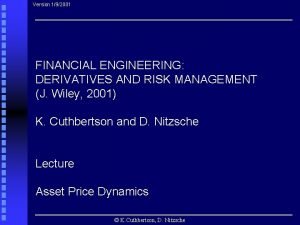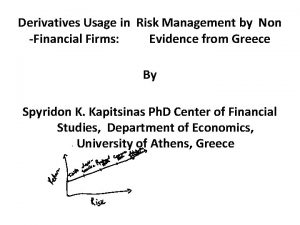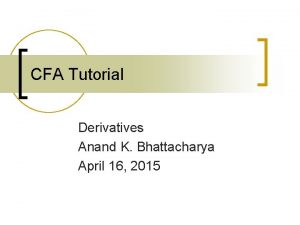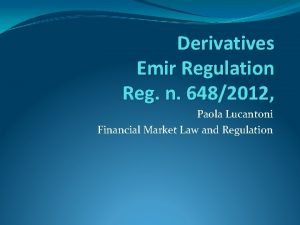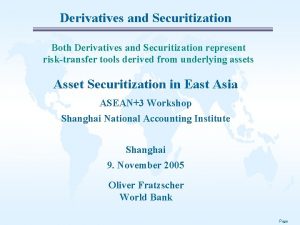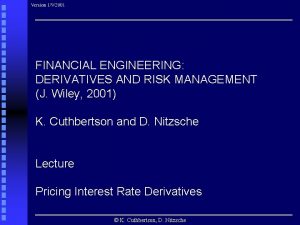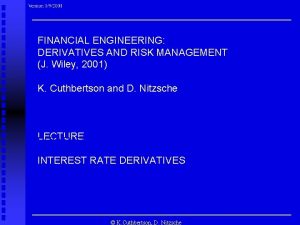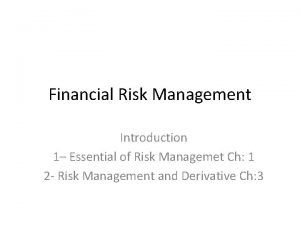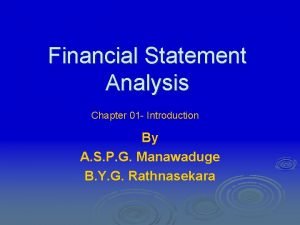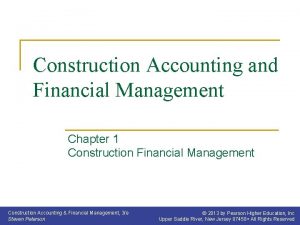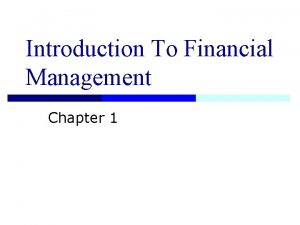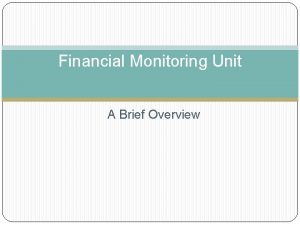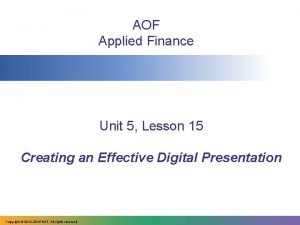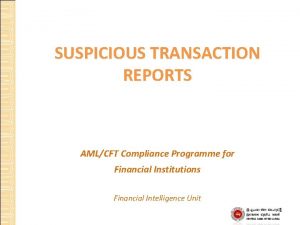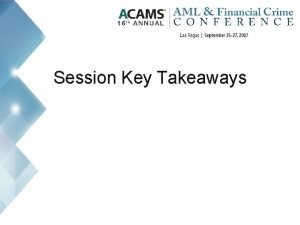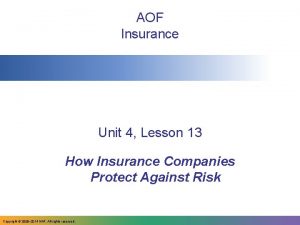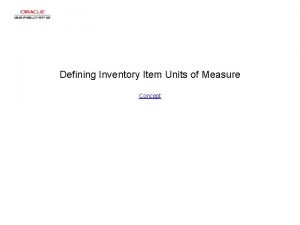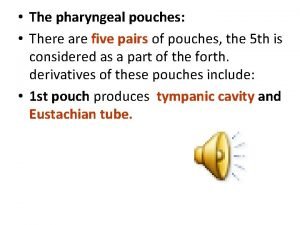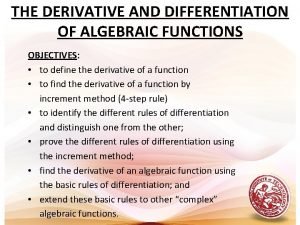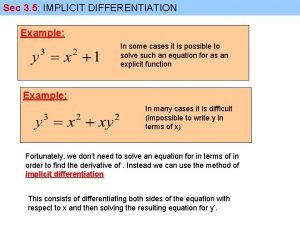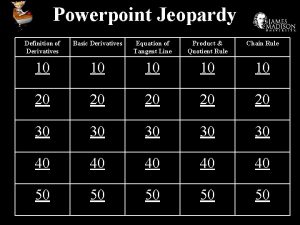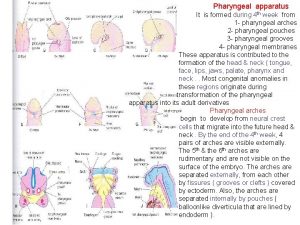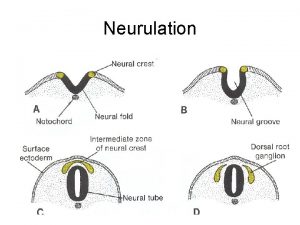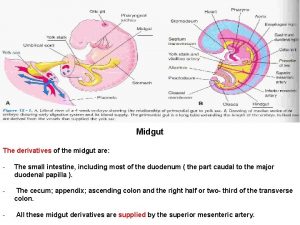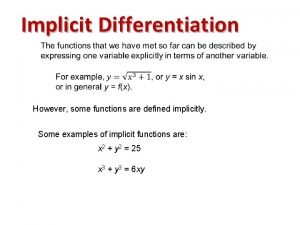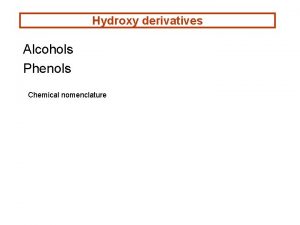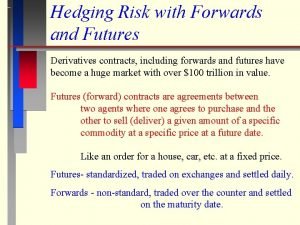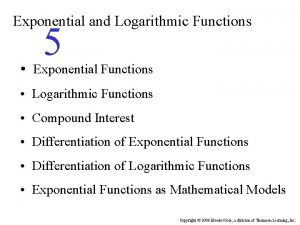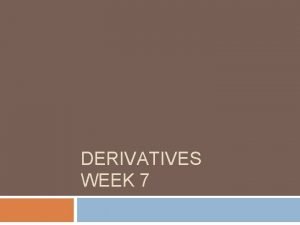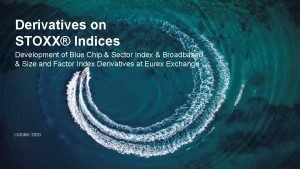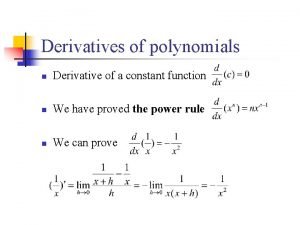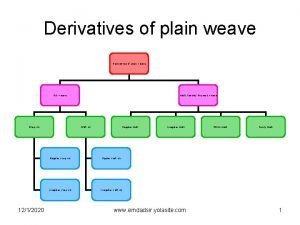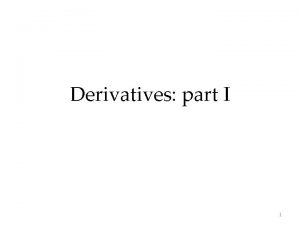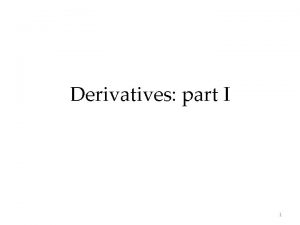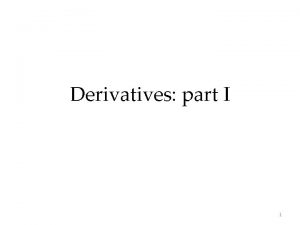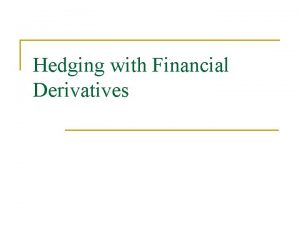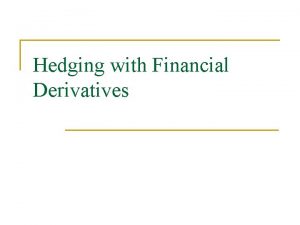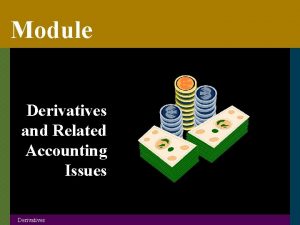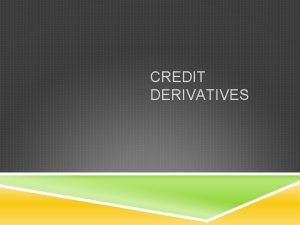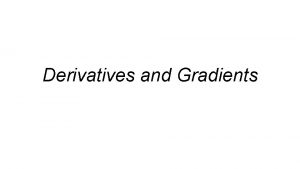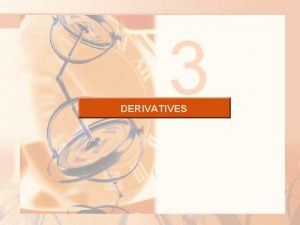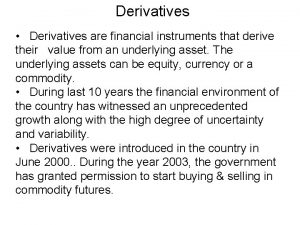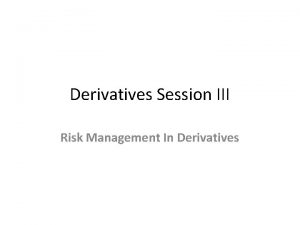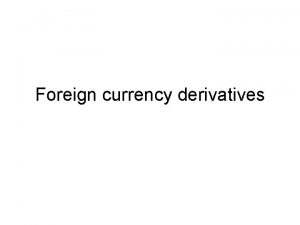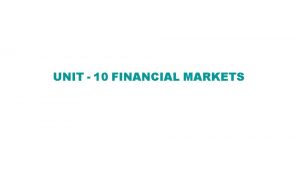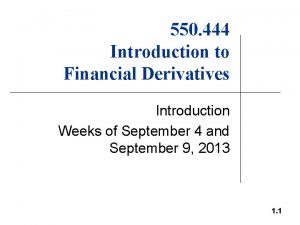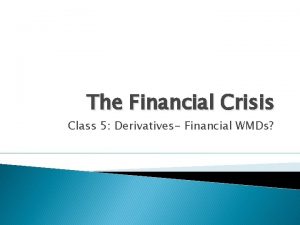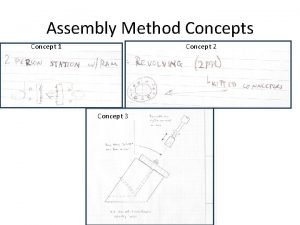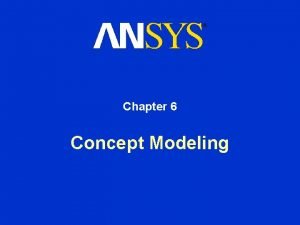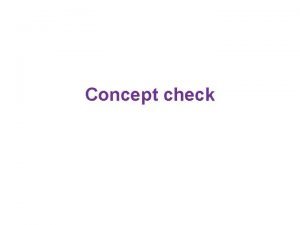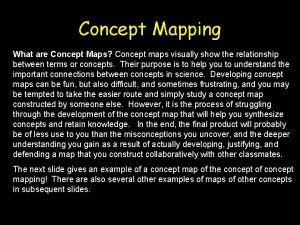Financial Derivatives Unit 1 Introduction Concept of derivatives




























































- Slides: 60

Financial Derivatives Unit 1 Introduction

Concept of derivatives • Derivatives are the contract between parties to purchase or sell specified assets at specific price on future date. All terms and conditions of transaction such as price of assets, quality, quantity, method of delivery of assets, date of delivery etc are fixed at present and actual transaction takes place in future.

Derivatives (Financial derivative) are the assets derived from other assets and in general, the value of such assets depends on the market price of the underlying assets. Examples of derivatives are option, forwards, futures, swap etc.

• Financial derivatives are a financial contract whose value depends on some other assets. Derivatives generally involve an agreement between two parties to exchange a standard quantity of assets at a predetermined price and at a specified date in future. Price of another asset on whom the value of financial derivative depends is known as an underlying asset. The value of derivative security changes when the price of the underlying assets to be exchanges. Underlying assets can be bonds, stocks, petroleum products, gold, silver etc.

• Example 1 Suppose you want to buy a new motor cycle. You go to the local dealer and select the type of motor cycle, its color, engine size, price etc. The dealer tells you that if you place the order today and place a deposit, then you can take delivery of motor cycle in 3 months time. If in three months time the dealer has any discount offer for new motor cycle or the price increases, it does not matter. The price you pay for the motor cycle on delivery has been agreed and fixed between you and the dealer. In this case, you have entered in to a forward contract. You have right and obligation to buy the motor cycle in 3 months.

• Example 2 Suppose you had gone to the show room and seen the car you wanted was on offer at Rs 20, 000 but you must buy the car today. You don’t have the amount of cash available and it will take you a week to organize the loan. You could offer the dealer a deposit and enter into a one week forward contract

• suppose you offer the dealer Rs 300 if he will just keep the car for a week and hold the price. At the end of the week Rs 300 is dealer’s income whether or not you buy the car. You have entered into the option contract. It is termed as call option contract in this case. This means you have right to buy the car in a week but not the obligation. If during the week, you discover the second dealer offering an identical model for Rs 19500 then you don’t take your option with the first dealer. The total cost of buying the car is now 19500 + 300 = 19800 which is cheaper than the first one.

• If you can’t find the car at a cheaper price and buy the car from first dealer, then the car will cost a total of Rs 20, 000 + 300= 20, 300. If you decide not to buy the car, you will lose your Rs 300. Example 1 and 2 are hedging against price rise in the car.

• Example 3 The car you have bought a call option for is very much in demand there is a sudden price rise to Rs 22000. A friend of yours also wants the same car and hears that you have an option to buy the car for R 20, 000 in a week time. After visiting the bank you decide that you can’t really afford to buy the car so you sell the option to but to your friend for Rs 500. Here you also earn Rs 200 on selling your option. Your friend gets the car for Rs 20, 000 by using option contract.

Example 4 Suppose Anish and Bhuwan make a contract today to exchange one tola of gold at Rs 50, 000 one year from today. Anish agrees to buy one tola of gold at Rs 50, 000 one year from today from Bhuwan also agrees to sell the same for Rs 50, 000 one year from now to Anish. This financial contract between Anish and Bhuwan is called Forward contract (A type of derivative security). The agreed price is called exercise price and underlying assets in this example is gold. If the price of gold one year from today becomes Rs 55, 000 in the market, Anish buys the gold at agreed price of Rs 50, 000 and sells the same at Rs 55, 000. Anish makes a financial gain of Rs 5000 which is the value of forward contract. The value of contract to Anish is + Rs 5000 and the value contract to Bhuwan is –Rs 5000. Thus the value of contract (derivative assets) is directly determined by the price of underlying assets.

Features of Financial derivatives • Two parties Financial derivatives are the financial contract between two parties to buy or sell certain assets on certain future date at price agreed today. No financial derivatives can be created without the agreement between two parties.

• Underlying assets The value of financial derivatives depends upon the value of other assets. Such assets are called underlying assets. If the market price of underlying assets is greater than the contracted price, there is gain to the buyer and same amount of loss to seller. If the market price of underlying assets is less than the contracted price, there is gain to seller and same amount of loss to buyer. The gain or loss of the contract due to change in market price of underlying assets is referred to as the value of derivative contract.

• Future transaction Financial derivatives are the agreement for future transaction. The actual transaction – delivery of assets and cash payment- takes place in future date. This date is called exercise date.

• Right and obligation Derivatives are obligatory for both parties. Both parties should meet their promises according to the contract. However there are some derivatives which give right to one party and obligation to another party. Futures, forwards and swap contracts are obligatory for both buyer and seller. . The buyer must buy and seller must sell the underlying assets. But option is a derivative security which gives the right to the holder or buyer of the contract to forgo the promise.

• Zero sum game is the game in which one party’s gain always equal to the loss of other party. Neither both parties can gain nor have to bear loss simultaneously. If payoffs (profit) of both are summed up, the result is always zero. For example – Sabita and Bidya entered into a contract where Sabita agreed to purchase 100 kgs sugar at Rs 50 after one year from Bidya. Suppose at the expiration date, if the market price of sugar reached to Rs 70, the payoffs for Sabita will be Rs 2000. There will be -2000 payoffs for Bidya at the same time. Here if we add these two payoffs, the result will be zero.

Financial derivatives as an asset. Assets Real Assets Financial assets Primary Securities derivative securities

• Real Assets includes Land buildings, plant and machinery, patents and trademarks etc. Real assets are the assets which has no corresponding liability. • Financial assets are also called paper assets. They are the assets of their buyers and liability of their issuer or seller. Financial assets can further divided into two categories • Primary assets – These are issued by government/ firm. These securities have corresponding liabilities. They obligate the issuer for the payment of some part of their income. Common stock, bond, preferred stock are examples of primary securities. • Derivative securities – These are securities created through contract between two parties. They do not have corresponding liabilities. Options, forwards, futures swap are some example of derivatives.

Traders in derivative market • Hedgers Hedging is the process of reducing the financial risk. Hedging is done by way of a transaction made in order to diminish the risk of price fluctuation of financial assets/ commodities. Parities involving in hedging are called hedgers. With hedging activities, the investor attempts to modify risk by undertaking investment positions such that the gain on one investment counterbalances the loss on another. Suppose Rohan wanted to buy a gold one year from now and was afraid of the price increase in the future. He can hedge his risk due to price increase by entering into a forward contract in which he agrees to buy the gold for predetermined price (say Rs 50, 000). In case price increases, he does not have to pay more than Rs 50, 000. That’s how he can hedge the risk.

• Speculators are defined as investors who take positions that increase their exposure to certain risks in the hope of increasing their wealth. Hedgers are the traders who wish to avoid the risk; speculators are those who are willing to take such risk. They believe that they have some specialized knowledge about the market and they can predict the direction of the market’s movement. Speculation is the betting in the price of financial assets/ commodities. Speculation therefore is a bet on future movement in the price of assets. For example Hary agrees to buy one tola of gold for Rs 50, 000 one year from today from Nirvik agrees to sell that for Rs 50, 000. Here, Hary has taken the long position to buy the gold at fixed price. He has taken the risk of loss from the unfavorable price movement in future. There is possibility of making high profit if the price of gold in the market moves in his favor. Here, Hary can be taken as speculator.

• Arbitrageur An arbitrageur is a trader who makes riskless profit at zero investment. Arbitrageur involves looking in a riskless profit by simultaneously engaging into transactions into two or more markets. An arbitrageur transaction involves buying assets at lower price and selling it at higher price. They seek to get benefit from market inefficiencies/ imperfections. In derivative market, arbitrageur opportunities can be captured by combining position in spot and derivative assets.

• Example. Current market price of gold is Rs 9000. Phoju is ready to buy gold from Rimal at Rs 10, 000 one year from now. Rimal also ready to sell gold to Phoju at Rs 10, 000 one year from now. Suppose Rimal can borrow the amount at the rate 10%. In such case Rimal borrow 9000 at the given interest rate for one year and buy the gold. Here Rimal makes riskless profit. He receives Rs 10, 000 from Phoju and give the gold. Then he pays back his loan with interest which is 9900. His profit which he knew at the time of contract is Rs 100. Rimal, in this case, is an arbitrageur.

Types of financial derivatives • Options are probably the most popular financial derivatives. An option is a derivative security that gives its buyer (owner) the right but not obligation to buy or sell assets at a predetermined price on or before a given date. There are two types of options. • Call option – A call option gives the holder right to buy the underlying assets. • Put option – A put option gives the holder right to sell the underlying assets. The price of the assets fixed by the contract is known as exercise price/ strike price and the date fixed in the contract is known as the exercise date. European option can be exercised only on the maturity date whereas an American option can be exercised at any time during its life.

• Forward contract A forward contract is a contract in which the buyer and seller agree upon the delivery of a specified quantity and quality of assets (usually commodities) at a specified future date. A forward contract sounds like an option but an option carries the right, not the obligation to go through the transaction. In other words two parties in forward contract incur the obligation to ultimately buy and sell the goods. These contracts are strictly traded in Over- The- Counter market.

• Future contract is a form of contractual agreement between a buys and sells for a specified assets on a fixed date in the future. Future contract, in many aspect, are similar with forward contract, however, future contract trade on organized exchange called future market and is regulated by government agencies. Whereas forward contracts are traded on OTC market and governed only by contract law. Unlike forward contract, future contract is settled daily which helps to reduce default risk from either party. Daily settlement is the provision in which the profit or loss of the future contract is calculated on the basis of daily market price of underlying assets.

• Swap A swap is a contract in which two parties agrees to exchange cash flows to each other at specific intervals over a specified period of time. For example, Sujita and Subechhya agree to enter into an agreement to exchange annual interest payments on Dec 30 each year for 3 years. Sujita promises to pay fixed interest rate of 10% at the end of each year on the amount of Rs 100 M to Subechhya. Similarly, Subechhya promises to pay variable interest rate on the amount of Rs 100 M to Sujita. The variable interest rate varies from year to year. Here both parties do not exchange the Rs 100 M to each other. They use Rs 100 M as the base to calculate the interest amount promised to be exchanged. Here Rs 100 M is called the notional principal.

Let’s assume that the variable interest rate is 12% at the end of year one. Now Sujita will pay Rs 10 M to Subechhya and Subechhya will pay Rs 12 M to Sujita.

Role of derivative markets • Risk management Primary use of derivatives is to manage the financial risk. Investors use derivatives to reduce risk are called hedgers and investors who seek to increase their risk in derivative market are called speculators. Derivative markets enable those wishing to reduce their risk to transfer it to those wishing to increase it. (i. e. from hedgers to speculators). Investors have different risk preference. Some are more tolerant of risk than others. All investors, however, wants to keep their investment at acceptable risk level. A wheat farmer may be anxious about the uncertain sale and low price of his crops at the time of harvest. So he can use future agreement to reduce uncertainty about the prices they will receive for their product.

• A farmer, for example, by agreeing through a future contract to deliver a certain amount of wheat at specified future date and price, avoids exposure to unfavorable price movements. Similarly export import business may have a risk exposure due to change in exchange rate between home currency and foreign currency involved in trade. A financial institution may have interest rate risk exposure. So, derivative markets give the platform to the investors to manage the risk.

• Price discovery Forward and future markets are important source of information about prices of assets in future date. Derivative markets are considered a primary means of determining the spot price of assets in future date. Prices in derivative market contain information about what people expect future spot price to be.

• Operational advantages Derivative markets offer three important operational advantages • It involves lower transaction costs (commission and other trading costs). • Derivative markets have greater liquidity than spot market. • Derivative markets allow investors to sell short securities easily. Securities markets impose several restrictions designed to limit or discourage the short selling that are not applied to derivative transactions.

• Market efficiency Arbitrage trading is quite common in derivative market. Due to such trading, the price of mispriced security is rapidly adjusted and market becomes efficient. Society benefits because the price of underlying goods more accurately reflect the goods true economic value.

Criticism of derivatives • Derivatives are the versatile financial instrument in the financial world. However derivatives have been criticized for having been the source of large losses by some investors. Derivatives are also criticized as a form of legalized gambling which involves social cost. But derivative market intended to provide benefit across the society by making financial markets function in a more organized way. In spite of these all, some important arguments of the critiques against derivatives as are follows;

• Increase volatility Some experts argue that derivatives play crucial role towards price stability and price discovery in the market. But other blame that derivatives are the root cause to increase volatility in assets price in spot market.

• Increased bankruptcies Since derivatives are highly leverage financial instruments, good outcome is very good whereas bad outcome is very bad. If someone takes position without calculating level of acceptable risk and faced massive losses, this will hamper the whole financial system. Modern financial system is interlinked to each other and consequences will be chain of default which ultimately leads to market failure. Thus if one bank goes bankrupt due to careless in using derivatives, whole financial system will be in problem.

• Increased regulatory burden Derivatives have unique features than traditional securities. So it requires more attention from government or regulatory authorities to control the activities and behavior of traders in derivative markets. There is always an issue about who should control the derivative market, should it be security board, central bank or separate board? Obviously it has increased the regulatory burden to government with the development of derivative market.

Misuse of derivative Derivatives contain a high degree of leverage, meaning that small price changes can lead large gain or losses. This is the most undesirable feature of derivatives. Due to versatile features of derivatives, they can cause problem as well. Having excessive confidence in one’s ability to forecast price or interest rate or exchange rate and then acting on those forecast by using derivatives can be extremely risky. For example the person who is assigned the job to hedge risk or follow an arbitrageur strategy, become speculator.

Career in derivative market The primary use of derivatives is to manage the risk. No matter whether we involve in small or big business, government or non government organization, we have to use derivatives to manage the financial risk. If we choose our career in the field of investment management, we surely need derivatives tools.

Importance of derivatives • To explore the new investment opportunities Primary securities like shares and bonds are not sufficient to meet the growing needs of present day investors. Financial derivatives are the alternative investment opportunities available to the investors to earn profit.

• To minimize the risk (hedging ) The main purpose of developing financial derivatives is to hedge against the risk. Hedging is the process of reducing the financial risk. Hedging is done by way of a transaction made in order to diminish the risk of price fluctuation of financial assets/ commodities. Parities involving in hedging are called hedgers. With hedging activities, the investor attempts to modify risk by undertaking investment positions such that the gain on one investment counterbalances the loss on another.

• To increase risk and return( Speculation) Derivatives are the contracts that require small amount of margin. Such assets provide high leverage. Therefore there is possibility of getting high profit with small investment. If traders could forecast the future trend of market, they are able to get large profit. Hence derivatives are attractive investment alternatives. The investor can gain in both bull and bear market by using derivative instruments. Long position gives benefit in bull market and short position gives benefit in bear market.

• Lock in an arbitrage profit Arbitrage is the process of making riskless profit from the mispriced assets in the market. Over price and under price of futures, options etc provide the arbitrage opportunity. Hence derivatives are used to capture the profit from disequilibrium.

• To change the nature of liabilities and assets Derivatives assets can be used to change the nature of assets or liabilities as way to manage interest rate risk. Financial institution pays interest on deposit and charge interest on lending. Some loan/ deposit carry fixed interest rate and some carry floating interest rate. Financial institutions use swaps to hedge against the risk of change in market interest rates.

Basic concepts in financial and derivative market • Some introductory concepts relating to investment opportunities and investors have been explained as follows; • Risk preference Every investor wants to get higher return from his/her investment. Therefore, he/she chooses higher yielding investment alternative. However return alone is not sufficient to evaluate investment alternatives. Level of risk involved in that alternative should be considered. Risk is defined as the variability of return. If the future return can be predicted accurately, the investment becomes risk free. There are three types of investors regarding their attitude towards risk.

• Risk Seeker A risk seeker investor is one who prefers risk. Given a choice between more and less risky investment with identical expected returns, this type of investor prefers the riskier investment. • Risk Neutral A risk neutral investor does not care about risk while selecting investment alternatives. He/she just compare is expected return.

• Risk averter A risk averse investor is an investor who prefer less risk to more for a given return. Risk averters, other things being equal, are investors who dislike volatility or risk. They always prefer certain investment over an uncertain investment as long as the expected returns on two investments are identical. The difference between expected return and risk free rate of return is known as risk premium. A high risk averse investor requires a large increase in risk premium to compensation even a small increase in risk.

• Short selling is the method that allows the investor to profit when a stock price falls. It is possible to sell an asset that we don’t own through the process of short selling. To do this, we borrow the assets from someone else who owns it, such as from brokerage firm and shortly sell the borrowed assets to someone else. At later date, we repay our loan by purchasing the assets and return the assets to the lender. If the later price (Buy back price) is lower than beginning price (selling price), we will make profit. Hence short selling is possible if the assets price declines.

• Risk and return Return is the numerical measure of investment performance. It represents the increase in the investors’ wealth that results from making the investments. One fundamental characteristic of investors is their desire to increase their return but the higher return is accompanied by higher risk. If risk is increased, return should also be increased. There is positive relationship between the return and risk which is known as risk return trade off.

• Market efficiency and theoretical fair value • Market efficiency implies that all known information is immediately evaluated by all investors and reflected in financial assets prices in financial market. As such no one has an information lack. In the ideal efficient market, everyone knows all possible information, interprets it similarly and behave rationally. However human being what they are, this is rare to happen in market. Market efficiency is the characteristics of a market in which the prices of instruments trading reflect their true value to the investors. True economic value is also called theoretical fair value. Spot and derivative markets are normally quite efficient An efficient market is a consequence of rational and knowledgeable investors behavior.

• Bull and Bear market If an investor thinks that the market’s performance is increasing, he/she is bullish investor. If any investor thinks the market performance is declining, he/she is bearish towards market. This means that an upward market is bull market and downward market is bear market.

• Types of traders Hedgers Speculators Arbitrageur

• Dealers and brokers in financial market • Dealers are financial institution or a firm who are always ready to purchase or sell the securities on their own accounts. They are also called market makers. They quote ask (selling) and Bid (purchase) prices. They make profit by charging high price on sale and paying low price to purchase. • Brokers are intermediary. They search the counterparty for buying and selling. They charge commission on trade.

• Financial market • It is the market where financial instruments are traded. It can be divided into two group; Primary market and secondary market. If securities are issued first time, it is the primary market. If already issued securities are traded, it is secondary market. Secondary market can further be divided on different basis;

• On the basis of organization • Organized exchange – An exchange is a legal corporate entity organized for the trading of securities, options, futures, forwards etc. It provides a physical location and facilities and stipulated rules and regulations. • Over the counter market (OTC market) – it is a telephone and computer network linked network of dealers who do not physically meet. Trades are done over the telephone and are usually between financial institutions or between financial institution and one corporate client.

• On the basis of time of transactions • Spot market – It is a market for immediate transaction. Delivery of goods and payment for purchase take place now. • Forward market – It is the market for trading in future at price agreed today. Delivery of goods and payment for purchase takes place in future date.

Linkage between spot and derivative market • Derivative instruments such as options, forwards and futures are available for the purchase and sell of spot market assets like stocks and bonds in future. The prices of derivatives are related to those of the underlying spot market instruments through several important mechanisms. General overview is presented below-

• Arbitrage and the law of one price • Arbitrage is a type of transaction in which an investor seeks to profit when the same assets sell for two different prices. If a stock sells on one exchange at one price and on another exchange at different price, arbitrageur will buy it at lower price from one exchange and sell at higher price at another exchange. Sometimes in our day to day life, we encounter the same commodity selling for two different prices. Prices may be different because of the difference between warranties and other services provide by the seller. However, sometimes there is difference in price of same commodity offering same utility. This type of differences provides arbitrage opportunities. Lets take an example to understand above explanation –

• Suppose there are two stock S 1 and S 2 and two possible states of economy one period later. If state one is occurred, price of S 1 is expected to increase to Rs 100 and price of S 2 is expected to be Rs 50. On the other hand if state two is occurred price of S 1 is expected to be Rs 80 and that of S 2 is expected to be Rs 40. This means that purchasing two S 2 securities or one S 1 security provides the same wealth to the investor. If S 1 is now selling for Rs 84, what must be price of S 2? Obviously it must be sold at Rs 42.

• Suppose S 2 now is selling for Rs 40, an arbitrageur can earn risk less profit at this situation. Arbitrageur can sell short the stock S 1, receive Rs 84, purchase two S 2 at Rs 80 and save Rs 4. One period later it sells two S 2 and proceeds will be sufficient to purchase one S 1 which is required to cover his/ her short position. By doing so he/she makes Rs 4 as risk less profit. This will lead to increase in selling pressure on the price of S 1 and buying pressure on the price of S 2 which pushes the price of S 1 up and the price of S 2 down until the price of S 1 equal the one half of S 2. This process of price adjustment is known as law of one price. This shows that the future price outcome for future transaction is set today which also affect the spot price as explained.

• Storage mechanism • We purchase and store different types of assets today. Holding a security is a form of storage. One can also buy a commodity such as wheat, corn and store it. Storage is a type of investment in which we postpone selling the assets today in expectation of selling it at later date. Storage of goods entails risk like opportunity cost, rent of warehouse, obsolescence and risk of price fluctuations. However such type of risk can be minimized by using derivatives such as forward or future contracts. By entering into a forward, one can contract to buy assets at future date. Thus he/she need not to buy and store assets today. So he/she can avoid costs related to the storage. The forward seller will not enter into the contract unless the forward price compensates his/her storage cost. Thus the forward price is determined by the spot price, storage cost, opportunity cost and estimated risk of price fluctuations. Therefore there is link between derivative and spot market.

• Delivery and settlement • At expiration a forward or future contract calls for either immediate delivery of the items or a cash payment of the same value. Thus an expiration forward or future contract is equivalent to a spot transaction. The price of the expiration contract, therefore, must equal the spot price.
 Financial engineering derivatives and risk management
Financial engineering derivatives and risk management Non financial derivatives
Non financial derivatives St x
St x Conclusion of financial derivatives
Conclusion of financial derivatives Conclusion of financial derivatives
Conclusion of financial derivatives Financial engineering derivatives and risk management
Financial engineering derivatives and risk management Financial engineering derivatives and risk management
Financial engineering derivatives and risk management Unit 10, unit 10 review tests, unit 10 general test
Unit 10, unit 10 review tests, unit 10 general test Non financial methods of motivation
Non financial methods of motivation Realself vs ideal self
Realself vs ideal self Contoh selling concept
Contoh selling concept Financial risk management introduction
Financial risk management introduction Financial problem introduction
Financial problem introduction Introduction of financial statement analysis
Introduction of financial statement analysis Construction accounting and financial management
Construction accounting and financial management Introduction to financial management
Introduction to financial management Scheduled banks vs non scheduled banks
Scheduled banks vs non scheduled banks Concept of pediatric nursing
Concept of pediatric nursing Concept of child care slideshare
Concept of child care slideshare Mind map on real numbers class 10
Mind map on real numbers class 10 Financial monitoring unit
Financial monitoring unit Unit 5 lesson 2 financial accounting
Unit 5 lesson 2 financial accounting Unit 5 lesson 2 financial accountings
Unit 5 lesson 2 financial accountings Unit 13 accounting and financial statements
Unit 13 accounting and financial statements Unit 5 lesson 2 financial accounting
Unit 5 lesson 2 financial accounting Unit 4 lesson 3 financial plans
Unit 4 lesson 3 financial plans Financial intelligence unit
Financial intelligence unit Financial intelligence unit
Financial intelligence unit Joint financial intelligence unit
Joint financial intelligence unit Joint financial intelligence unit 香港
Joint financial intelligence unit 香港 Unit 2 lesson 3 health insurance and financial planning
Unit 2 lesson 3 health insurance and financial planning Unit 2 lesson 3 health insurance and financial planning
Unit 2 lesson 3 health insurance and financial planning Concept of intensive care unit
Concept of intensive care unit Principle of material handling
Principle of material handling Inventory units of measure list
Inventory units of measure list Essay structure introduction
Essay structure introduction Lateral lingual swellings
Lateral lingual swellings Algebraic differentiation
Algebraic differentiation Differentiate trigonometric functions
Differentiate trigonometric functions Sabyonne
Sabyonne Basic derivatives
Basic derivatives Pharyngeal arches diagram
Pharyngeal arches diagram Pharyngeal pouches derivatives
Pharyngeal pouches derivatives Least reactive carboxylic acid derivatives
Least reactive carboxylic acid derivatives Neurulation
Neurulation Derivatives of the midgut
Derivatives of the midgut Implicit differentiation matlab
Implicit differentiation matlab Hydroxy derivative
Hydroxy derivative Germ layers of embryo
Germ layers of embryo Higher order derivatives notation
Higher order derivatives notation Hedging in forward market
Hedging in forward market Sclerotom
Sclerotom Derivative of an exponential
Derivative of an exponential Development of superior vena cava
Development of superior vena cava Vitelline vein derivatives
Vitelline vein derivatives Spoticash scam
Spoticash scam Istoxx factor indexes futures
Istoxx factor indexes futures Constant multiple theorem
Constant multiple theorem Derivatives of plain weave
Derivatives of plain weave Exponential differentiation
Exponential differentiation Cosx-sinx formula
Cosx-sinx formula
